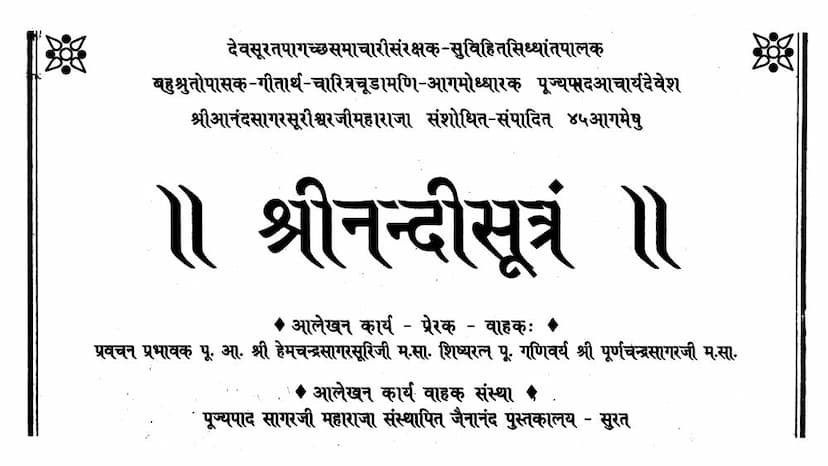Agam 44 Chulika 01 Nandi Sutra Shwetambar
Added to library: September 1, 2025

Summary
Here is a comprehensive summary of the provided Jain text, focusing on the content relevant to the Nandi Sutra:
Book Title: Agam 44 Chulika 01 Nandi Sutra (Shwetambar tradition) Author(s): Sudharmaswami, Purnachandrasagar (editor/compiler) Publisher: Jainanand Pustakalay Catalog Link: https://jainqq.org/explore/021046/1
Overall Context:
This document is the Nandi Sutra, a significant Agam text within the Shwetambar Jain tradition. The provided text includes a preface (Prastavana), the Sutra itself (in Prakrit with Hindi translation/explanation), and acknowledgments and details about its publication.
Key Themes and Content:
-
Significance of Agamas (Pages 3-8):
- The preface emphasizes the crucial role of the Agamas (scriptures) as the word of Lord Mahavir and a guiding light for beings lost in the cycle of rebirth.
- It details the history and importance of the six "Vachanas" (recitations or compilations) of the Agamas, which occurred over a period of 1000 years after Lord Mahavir's nirvana. These Vachanas were undertaken to preserve the Agamic knowledge due to various calamitous events, famines, and the dispersal of monks.
- The text highlights the meticulous efforts made by various Acharyas and monks throughout history to collect, preserve, and compile the Agamas, often involving memorization and later, transcription onto palm leaves and printing.
- It specifically mentions the efforts of Acharya Shri Anand Sagar Surishwarji Maharaj in re-editing and republishing the Agamas in the 20th century, playing a vital role in their dissemination.
- The publication is attributed to the efforts of Acharya Shri Purnachandra Sagarji Maharaj, a disciple of Acharya Shri Anand Sagar Surishwarji Maharaj, who undertook the editorial work.
-
The Nandi Sutra Content (Pages 9-44):
- Invocation and Praise: The Sutra begins with invocations and praise to Lord Mahavir, highlighting his qualities as the source of knowledge, the protector of the world, and the ultimate Tirthankar (Pages 9-10).
- Praise of the Sangha: There are verses praising the Jain Sangha (community) as a source of virtue and a pillar of support (Page 10).
- Genealogy of Ganadharas: The text lists the eleven Ganadharas (chief disciples of Lord Mahavir), starting with Indrabhuti Gautama, and their respective lineages (Page 11). It also mentions other prominent Acharyas like Bhadrabahu, Sthulabhadra, Aryarakshit, Vasunandi, and Nagajun.
- Classification of Knowledge (Prakaran): A significant portion of the Nandi Sutra, as presented here, focuses on the classification and explanation of knowledge (Jnana).
- Five Types of Knowledge (Jnana): The text systematically explains the five types of knowledge:
- Abhinibodhik Jnana (Sensory/Empirical Knowledge): Detailed explanation of how this knowledge is acquired through the senses and mind, its different stages (Uggraha, Iha, Avaya, Dharana), and its types.
- Shruta Jnana (Scriptural Knowledge): The text delves into the vastness and classification of scriptural knowledge, its connection to Abhinibodhik Jnana, and the structure of the Angas and Upangas.
- Avadhi Jnana (Clairvoyance): Explanation of Avadhi Jnana, its origin (born from karma or virtue), its scope (limited or extensive, spatial and temporal), and its types (Anugami, Ananugami, Vardhaman, Hiyaman, Pratipati, Apratipaati).
- Manahparyaya Jnana (Telepathy): Detailed explanation of Manahparyaya Jnana, its capacity to understand the thoughts of others, its limitations, and its types (Rjumati and Vipulmati).
- Kevala Jnana (Omniscience): The ultimate knowledge, described as pure, eternal, and all-encompassing. It is further classified into Bhavastha Kevala Jnana (manifest during life) and Siddha Kevala Jnana (after liberation).
- Classification of Knowledge based on Modes: The text also explains how knowledge is understood through different lenses: Dravya (substance), Kshetra (space), Kala (time), and Bhava (state/quality).
- Five Types of Knowledge (Jnana): The text systematically explains the five types of knowledge:
- Structure of the Agamas (Angas and Upangas): The text elaborates on the twelve Angas (primary scriptures) and various Upangas (secondary scriptures), detailing the content and structure of each Anga, such as:
- Acharanga Sutra
- Sutrakritanga Sutra
- Sthana Sutra
- Samavaya Sutra
- Vyakhyaprajnapti (Bhagavati Sutra)
- Naya-dharmakathaa
- Upaasakadasaa
- Antakritadasaa
- Anuttaraupaapaatikadashaa
- Prashna Vyakaran
- Vipaka Sutra
- Drishtivada
- Nandi Sutra's Focus: While the entire document relates to Jain Agamas, the Nandi Sutra itself, as presented here, primarily serves as an introductory or foundational text. It discusses the nature of knowledge, the importance of scripture, the lineage of teachers, and the fundamental principles of Jainism. The extensive classification of knowledge (Jnana) is a hallmark of the Nandi Sutra.
- The "Anu-yoga" (Postscript/Explanation): The latter part of the Nandi Sutra, as presented, also touches upon the concept of "Anu-yoga," which refers to analytical explanations and the systematic study of scriptures. It discusses the various ways scriptures are studied and understood.
- The concept of "Anunnana" (Page 37-43): This section seems to explore the concept of how scriptures or knowledge are named, designated, or referred to. It differentiates between various ways of understanding and transmitting knowledge.
Editorial and Publication Details:
- The text emphasizes the historical significance of the Agamas and the lineage of Acharyas who preserved them.
- It acknowledges the contributions of several Acharyas, including Acharya Shri Anand Sagar Surishwarji Maharaj for his original editing and Acharya Shri Purnachandra Sagarji Maharaj for the current compilation and editing work.
- The publication is by Jainanand Pustakalay, Surat, and the first edition was published in Samvat 2061 (approximately 2004 CE).
- The text lists various individuals and institutions that supported the publication.
In essence, this document is a detailed exposition of the Nandi Sutra, a foundational Jain scripture that meticulously classifies and explains the various types of knowledge, the structure of the Agamas, and the historical preservation of Jain scriptures.